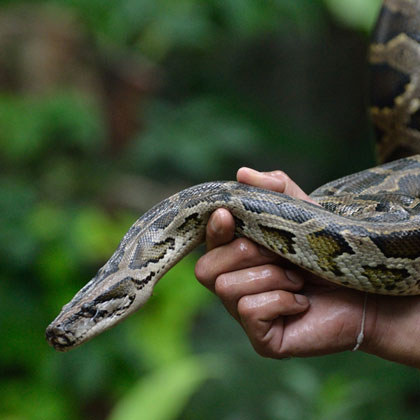Biodiversity Science and Action

Biodiversity Science and Action
Biodiversity affects our global environment and economy but we lack the scientific knowledge and economic systems required to manage it effectively. Recent research reveals the magnitude of these shortcomings, the questions that must be addressed, and the urgent need for solutions.
Dasgupta, P., & Levin, S. (2023). Economic factors underlying biodiversity loss. Philosophical Transactions of the Royal Society of Britain, 378: 20220197.
Dornelas, M., Chase, J.M., Gotelli, N.J., Magurran, A.E., McGill, B.J., Antao, L.H., Blowes, S.A., Daskalova, G.N., Leung, B., Martins, I.S., Moyes, F., Myers-Smith, I.H., Thomas, C.D., & Vellend, M. (2023). Looking back on biodiversity change: lessons for the road ahead. Philosophical Transactions of the Royal Society of Britain, 378: 20220199. DOI: 10.1098/rstb.2022.0199
Karolyi, G.A., & Tobin-de la Puente, J., (2023). Biodiversity finance: A call for research into financing nature. Financial Management, 52:231-251. DOI: 10.1111/fima.12417
The White House. (2023). National Strategy to Develop Statistics for Environmental-Economic Decisions: A U.S. System of Natural Capital Accounting and Associated Environmental-Economic Statistics. Office of Science and Technology Policy, Office of Management and Budget, Department of Commerce.
A recent paper in the Philosophical Transactions of the Royal Society of Britain shows that a revolution in economic thinking is required to manage biodiversity. Dr. Partha Dasgupta is a British economist at the University of Cambridge. He previously published the influential Dasgupta Report evaluating global biodiversity economics. Dr. Simon Levin is a professor of ecology and evolutionary biology at Princeton. Their paper argues that economic theory has treated civilization as separate from nature and should have valued natural assets more adequately. Models are overly confident and rely upon an assumption of unlimited growth. New technologies have increased GDP and extracted more resources than Earth’s systems can sustainably provide. Our ecosystems are sensitive and finite, and humans should treat them accordingly. They are a unique asset requiring purposeful management. Humans are “embedded in nature,” so we must include natural assets within the economic policy framework. For example, we should have access to natural resources in “inclusive wealth” assessments and calculate net present value in terms of well-being across generations.
These arguments reveal the underlying fallacy that leads to environmental degradation. The authors provide specific recommendations on how to build our global economy in a more sustainable direction. However, we do not want to fly unquestioningly. We must obtain reliable empirical evidence on how biodiversity functions in different regions and what financial instruments will produce effective results.
A second paper in the Philosophical Transactions takes up this very issue. Biodiversity specialist Dr. Maria Dornelas led a global team of scientists examining our ability to measure biodiversity changes across the planet. They noted that scientists have debated this issue for many years. Metanalyses performed decades ago yielded conflicting results on whether biodiversity was changing. Subsequent years have seen an explosion of new data and methods for measuring biodiversity, but these recent efforts have created a series of contemporary issues. The data shows substantial variation across different scales and according to other measurements. Many studies are compromised by sampling limitations and knowledge gaps. They also contain biases in measurement scale, conceptual frameworks, and factors assumed to create biodiversity change. As a result, we cannot reliably measure how biodiversity changes across different scales. This uncertainty reduces our ability to understand which economic changes are beneficial, how they are helpful, and how they compare to alternative options. If we cannot reliably measure biodiversity changes, how will we determine the effects of new economic developments? How can we meaningfully distinguish the impact of new policies from other influences?
Our economists will develop new accounting methods, and our scientists will produce high-quality data for us. However, we must still deploy specific financial and regulatory solutions to protect biodiversity. Andrew Karolyi is the Dean of the Cornell SC Johnson College of Business. John Tobin-de la Puente is an ecologist and corporate lawyer who previously worked as the global head of sustainability at Credit Suisse. These authors recently reviewed previous conceptualizations of biodiversity, attempts to value it, indices for measuring it, and policies trying to protect it. They acknowledge growing support for new protections like biodiversity credits. But they also point to a disturbing gap between current conservation spending and what is needed to protect biodiversity. This gap could be as large as several hundred billion dollars a year. They note that private capital may increase spending while public regulation may be able to control access to resources. However, the government still directs most funding to other problems like carbon sequestration, agriculture, and forestry. There is no current estimation for the extent of overlap or adjustment to biodiversity as a parallel metric. Thus, we do not have financial systems that directly maintain biodiversity benefits and mitigate losses. We need more understanding even to establish them. Dr. Karolyi and Dr. Tobin urgently call for new research connecting financial performance with the effects on biodiversity, uniform and reliable ways of quantifying biodiversity to measure the impact of solutions, and adequate evaluations of investments in terms of biodiversity results. Risk management and divestment also need to be better understood regarding biodiversity.
These authors provide a concrete list of problems for us to address. One could ask if acting on our current imperfect understanding is possible. Even creating some effective, preliminary solutions that we can later refine with future scientific precision or financial instruments may be worthwhile. But to do this, we must grasp the nature of the problem. It is not simply a crisis; it is an error of omission. A comparison with related issues like carbon sequestration illustrates just how far behind we are with biodiversity. We need institutions like the IPCC and UNFCCC to provide information and manage international policy. There is no large-scale biodiversity credit market, not even one we may criticize and improve. We do not understand how real-world situations will combine with policy to influence pricing, create new markets or restrict current ones, change human behavior regarding management and economic activity, and alter the populations of endangered or keystone species. Thus, the recent natural capital accounting report from the White House recommended further “specific guidance documents” for biodiversity.
Scientists and policymakers must work together to change our philosophical orientation, obtain reliable information, and deploy new financial instruments that effectively maintain biodiversity. This kind of collaboration will require systems thinking and interdisciplinary efforts. But we must do this under a new context while learning from other analogous conservation efforts. Environmental leaders must perform this work as soon as possible to have a real, measurable impact before it is too late. The biological reality of biodiversity requires us to produce something with a greater understanding of living ecology that is less reductionist in treating ecosystem elements as assets. It should also include other ways of seeing the natural world, including local connections, spirituality, aesthetic and cultural values, and traditional indigenous knowledge.




